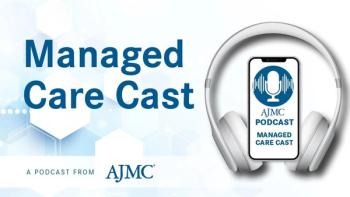
Study Highlights Treatment Patterns, Costs for DLBCL Not Treated With Stem Cell Transplant
Most patients in the cohort received rituximab plus cyclophosphamide, doxorubicin, vincristine, and prednisone for first-line therapy; hospitalization was prevalent; and average medical and pharmacy costs were more than $140,000 per patient per year.
New research highlights treatment patterns, health care resource utilization (HCRU), and costs associated with patients who have
Of a 750-patient cohort, 86.8% received rituximab plus cyclophosphamide, doxorubicin, vincristine (Oncovin), and prednisone (R-CHOP) for first-line therapy, and rituximab (39.5%) or bendamustine ± rituximab ± other (16.3%) for second-line therapy. Hospitalization was also prevalent for these patients, with a mean (SD) of 16.5 (25.8) hospital days per patient per year (PPPY). Additionally, the mean medical and pharmacy costs were $141,532 ($189,579) PPPY, with DLBCL-related claims being the primary cost driver.
These findings were published in
DLBCL is a prevalent and aggressive lymphoma subtype in the US, accounting for a significant proportion of lymphoma diagnoses. Despite advancements in DLBCL therapy, first-line treatment with the R-CHOP regimen has remained the standard for nearly 2 decades. Although a substantial number of patients achieve cure with this regimen, those who experience primary refractory disease or relapse face poor survival outcomes, and for patients not intended for hematopoietic stem cell transplantation (HSCT), there is a lack of effective second-line treatment options.
Current clinical practice guidelines recommend novel agents or rituximab-based chemotherapy regimens with palliative intent for this challenging patient subgroup. In this study, the researchers aimed to fill the research gap by examining demographic factors, treatment patterns, and estimating HCRU and total health care costs among US patients with DLBCL whose first-line treatment has failed and who did not receive HSCT as second-line treatment.
Regarding treatment patterns, most patients (71.7%) did not continue treatment beyond second-line therapy. R-CHOP was the predominant regimen in first-line treatment, with 75.2% of patients receiving R-CHOP alone and 11.6% receiving R-CHOP plus another agent; the median duration of first-line therapy was 4.1 months.
Following first-line therapy, patients who initiated second-line treatment did so after approximately 9 months, and the most frequent second-line treatments included rituximab monotherapy as well as bendamustine ± rituximab ± other. Similar to first-line treatment, the median duration of second-line therapy was 4.1 months, and subsequent lines of therapy often involved rituximab.
HCRU in the studied patient group indicated an average of 68.1 medical visits PPPY, with 50.4% of patients experiencing at least 1 inpatient visit and an average length of stay of 16.5 days PPPY. All patients had outpatient visits, averaging 66.0 visits PPPY and 26.2 pharmacy claims PPPY. Approximately 89% of the population had DLBCL-related outpatient visits, averaging 28.7 visits PPPY. The prevalence of DLBCL-related inpatient hospitalizations was 36.3% PPPY, with an average of 2 admissions PPPY and an average length of stay of 17.5 days PPPY.
Across the entire follow-up period, patients incurred mean total inpatient hospitalization costs of $80,197 PPPY ($6678 per patient per month [PPPM]), outpatient costs of $85,299 PPPY ($7103 PPPM), and emergency department (ED) costs of $2898 PPPY ($241 PPPM). For DLBCL-related admissions, inpatient hospitalization costs were higher at $91,456 PPPY ($7616 PPPM), while outpatient costs were almost half that at $48,257 PPPY ($4019 PPPM); ED costs were again higher at $4817 PPPY ($401 PPPM). The overall medical and pharmacy cost for the DLBCL study population averaged $141,532 PPPY ($11,786 PPPM) during the follow-up period.
Several limitations should be acknowledged in this study, including the lack of International Classification of Disease coding in pharmacy claims data that prevents the distinction between DLBCL-related and non–DLBCL-related drug costs. Additionally, relevant clinical factors, including International Prognostic Index risk factors and genetic information, were not available, and the use of commercial claims data supplemented with Medicare and Medicaid claims may lead to inaccuracies in categorizing treatment patterns and lines of therapy. Data sources also did not provide information on HSCT intentions, and race, socioeconomic status, and other factors associated with diagnosis, treatment, and costs were not available, limiting the generalizability of the results.
According to the authors, the study likely underestimates disease-related costs, as indirect costs and out-of-pocket expenses were not captured, and the more restrictive criterion for treatment may introduce selection bias and misclassification, potentially resulting in underestimation of estimates.
According to the authors, despite these limitations, the results highlight that treatment for patients with relapsed or refractory DLBCL is resource intensive and costly.
“The data highlight a wide variation in treatment patterns, a lengthy duration of hospitalizations, and a high amount of outpatient visits,” they noted. “Despite recent treatment advancements for such patients, there is still a need for more effective therapy options to reduce clinical and economic burden in this population.”
Reference
Acheampong T, Gu T, Le TK, Keating SJ. Treatment patterns and costs among US patients with diffuse large B-cell lymphoma not treated with 2L stem cell transplantation. Future Oncol. Published online January 17, 2024. doi:10.2217/fon-2023-0385
Newsletter
Stay ahead of policy, cost, and value—subscribe to AJMC for expert insights at the intersection of clinical care and health economics.














































